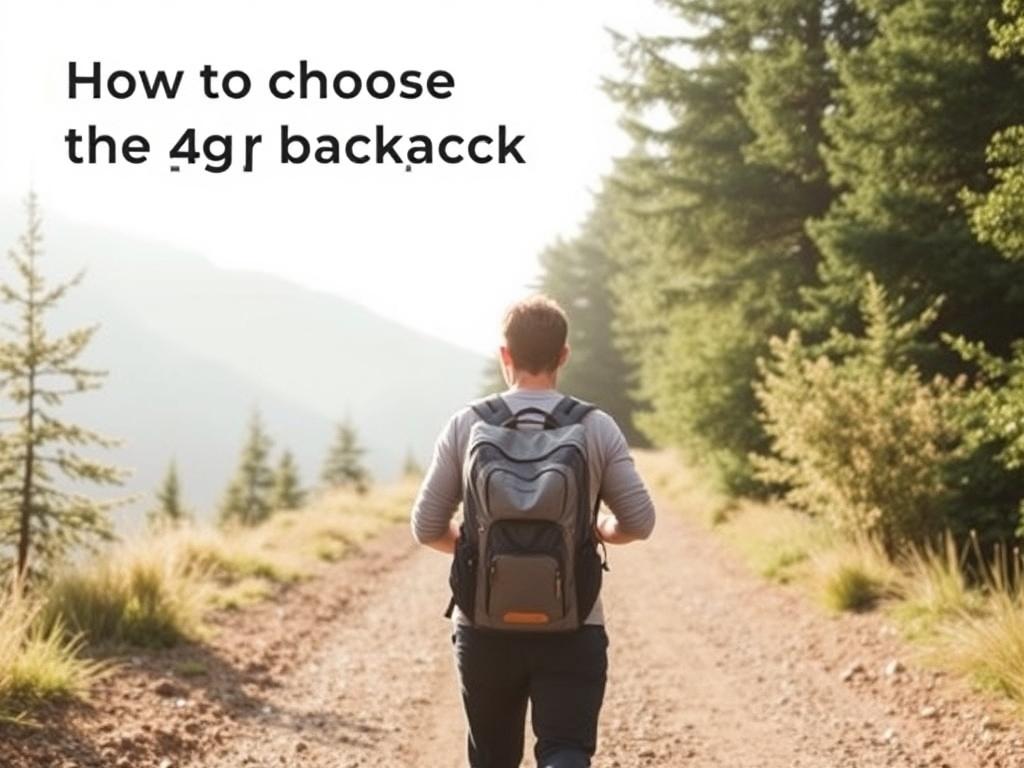
How to Choose the Right Backpack: Your Ultimate Guide to Finding the Perfect Fit
Choosing the right backpack might seem straightforward at first glance, but anyone who’s ever struggled with an uncomfortable bag knows how important it is to get it right. Whether you’re a student hauling textbooks, a traveler exploring the world, or an outdoor enthusiast hitting the trails, the right backpack can make all the difference in your comfort, convenience, and even your health. Let’s dive into everything you need to consider to find the perfect backpack for your needs.
Understanding Your Needs: What Will You Use Your Backpack For?
Before you start browsing for backpacks, it’s vital to get a clear picture of what you’ll be using your backpack for. Different activities call for different features, sizes, and styles. Are you a daily commuter who needs a bag to carry a laptop and some lunch? Or maybe you’re gearing up for a multi-day hiking trip with a heavy load?
Taking the time to analyze your needs will save you from ending up with a backpack that’s too small, too bulky, or missing important compartments. Some backpacks are designed with casual day-to-day use in mind, while others focus on specialized functions like hydration compatibility, extra padding for heavy weights, or protection against the elements.
Types of Backpacks and Their Typical Uses
| Backpack Type | Main Features | Best For |
|---|---|---|
| Daypack | Compact size, lightweight, minimal compartments | Short trips, school, daily commute |
| Travel Backpack | Larger capacity, multiple compartments, durable materials | Travelers, weekend trips, airport check-in compliant |
| Hiking Backpack | Hydration compatibility, padded straps, ventilation, frame support | Hikers, campers, outdoor enthusiasts |
| Laptop Backpack | Padded laptop compartment, tech organization, ergonomic design | Students, professionals, digital nomads |
| School Backpack | Spacious main compartment, pencil cases, easy access pockets | Students, children |
Size Matters: How Big Should Your Backpack Be?
One of the first considerations when selecting a backpack is its size or capacity. Backpacks are generally measured in liters, and this capacity directly relates to how much you can pack inside. Understanding how to determine the right backpack size can prevent frustration and discomfort.
For example, if you just need a bag for everyday essentials, a 15-25 liter backpack (often called a daypack) is usually plenty. For students carrying textbooks, 20-30 liters is common. On the other hand, hikers or travelers who need to pack clothes, gear, or supplies might require 40 liters or more.
Choosing Backpack Capacity Based on Activity
- Day-to-day use: 15-25 liters
- School or office: 20-30 liters
- Travel or weekend trips: 30-50 liters
- Extended hiking or trekking: 50-70+ liters
Keep in mind, bigger isn’t always better. Packing a huge backpack just because it can fit more will only weigh you down unnecessarily. At the same time, a backpack that’s too small may leave your belongings cramped, leading to potential damage or discomfort.
Comfort and Fit: How to Make Sure Your Backpack Works with Your Body
When looking for the right backpack, comfort is a crucial factor. A backpack that doesn’t fit your body properly can cause back pain, shoulder strain, and lead to poor posture. Luckily, today’s backpacks come with many adjustable features to help customize the fit.
Key Comfort Features to Consider
- Padded Shoulder Straps: Look for thick padding that absorbs pressure and prevents digging into your shoulders.
- Adjustable Straps: Shoulder, chest (sternum), and waist (hip) straps can help distribute weight evenly.
- Back Padding and Ventilation: Breathable, cushioned back panels help reduce sweating and add support.
- Frame Support: Internal or external frames help stabilize the load and maintain posture.
How to Measure for the Perfect Backpack Fit
Getting the right size pack relative to your torso length and waist size is vital. Here’s a simple step-by-step guide:
- Measure your torso length: Find the bony bump at the base of your neck (C7 vertebra) and the top of your hip bones. Use a measuring tape to find the distance between these points.
- Select a backpack that matches your torso length: Brands usually provide sizing charts for this.
- Adjust straps to fit snugly: When you wear the backpack, make sure the bulk of the weight sits on your hips, with shoulder straps adjusted so they hold the bag close but don’t cause pressure.
Material and Durability: What to Look for in a Backpack’s Build
Another important factor is the material and construction quality of the backpack. You want a sturdy, durable backpack that can handle everyday wear or rugged outdoor conditions, depending on your use.
Common materials used for backpacks include:
- Nylon: Lightweight, durable, abrasion-resistant, and often water-repellent. Popular for hiking and travel backpacks.
- Polyester: More affordable, offers good durability, often found in casual and school backpacks.
- Canvas: Heavy-duty and stylish but typically heavier and less water-resistant.
- Leather: Durable and fashionable but requires care and is usually heavier and more expensive.
Pay attention to zippers, stitching, and reinforcement in stress points like the bottom of the bag and strap attachments. High-quality brands focus on these details to ensure the backpack lasts for years.
Organizational Features: Keeping Your Items Accessible and Safe
When considering how to choose the right backpack, think about your organizational needs. A good backpack helps keep your items secure, protected, and easy to find.
Helpful compartments and features to consider
- Laptop Sleeves: If you carry a laptop or tablet, padded compartments protect your device.
- Multiple Pockets: Side pockets for water bottles, front pockets for small items, and internal compartments for better organization.
- Security Features: Hidden zippers, lockable compartments, and anti-theft designs for travelers.
- Hydration Reservoirs: For hikers, backpacks compatible with hydration bladders are a bonus.
Make a list of the essentials you want to carry and ensure the backpack’s compartments line up with those needs — this will make your daily routines or adventures smoother.
Style and Appearance: Matching Your Personality and Occasions
While function is king, the style of a backpack also matters. You’ll be wearing it frequently, so it’s good to like how it looks, whether you prefer sleek and minimal designs, vibrant colors, or rugged outdoor aesthetics.
Different environments may call for different styles: A professional laptop backpack with a clean design might not be ideal for a camping trip, and the bulk of a travel backpack might look out of place in an office setting. Many brands now combine style with functionality, so you don’t have to compromise.
Budget Considerations: How Much Should You Spend on a Backpack?
Backpacks range wildly in price—from affordable models under $30 to premium backpacks costing $200 or more. While it’s tempting to pick the cheapest option, keep in mind that investing a bit more in quality can pay off with increased comfort, durability, and satisfaction.
Here’s a rough guide to what you can expect at different price points:
| Price Range | Features and Quality | Typical Use |
|---|---|---|
| Under $50 | Basic materials and features, limited durability | Casual daily use, occasional travel |
| $50 – $100 | Better materials, improved comfort features, moderate durability | School, work, moderate travel |
| $100 – $200 | High-quality construction, specialized features, excellent comfort | Frequent travel, hiking, professional use |
| $200+ | Top-tier materials, advanced ergonomics, durability, and warranties | Serious hikers, heavy users, long-term investment |
Additional Tips and Tricks for Choosing the Right Backpack
To wrap up your backpack search, here are some insider tips you might not think about:
- Try it on loaded: Bring some items or weights to replicate your usual load and test how the backpack feels.
- Consider warranty and brand reputation: A warranty can provide peace of mind, and well-known brands often ensure better support.
- Check user reviews: Real experiences can reveal hidden pros and cons.
- Think about maintenance: Can you easily clean the backpack? Is it water-resistant or does it require extra protection?
- Test adjustability: Ensure straps and buckles are easy to use and reliable.
Choosing the right backpack is more than just picking one that looks good or is affordable. It’s about matching your lifestyle, comfort needs, and durability expectations to a product that supports you every day or on your adventures.
Conclusion
Finding the perfect backpack is like finding a trusted companion that stays with you through daily life or thrilling journeys. By first understanding what you’ll use it for, carefully considering size, fit, material, and features, and balancing style with budget, you can confidently select a backpack that feels like it was made just for you. Don’t rush the process—take your time to test options, read reviews, and think about what matters most to your comfort and convenience. After all, the right backpack doesn’t just carry your belongings; it enhances your entire experience, making every trip or task lighter, easier, and more enjoyable. So, gear up thoughtfully, and get ready to explore with a backpack that truly fits your world.




